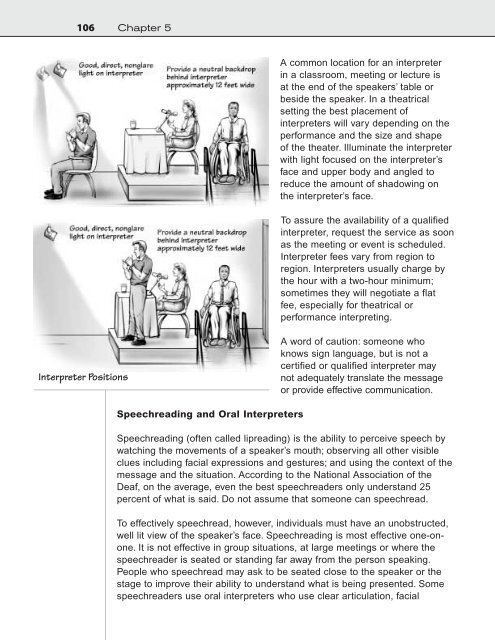Design for Accessibility: A Cultural Administrator's Handbook
Design for Accessibility: A Cultural Administrator's Handbook
Design for Accessibility: A Cultural Administrator's Handbook
Create successful ePaper yourself
Turn your PDF publications into a flip-book with our unique Google optimized e-Paper software.
106 Chapter 5<br />
A common location <strong>for</strong> an interpreter<br />
in a classroom, meeting or lecture is<br />
at the end of the speakers’ table or<br />
beside the speaker. In a theatrical<br />
setting the best placement of<br />
interpreters will vary depending on the<br />
per<strong>for</strong>mance and the size and shape<br />
of the theater. Illuminate the interpreter<br />
with light focused on the interpreter’s<br />
face and upper body and angled to<br />
reduce the amount of shadowing on<br />
the interpreter’s face.<br />
To assure the availability of a qualified<br />
interpreter, request the service as soon<br />
as the meeting or event is scheduled.<br />
Interpreter fees vary from region to<br />
region. Interpreters usually charge by<br />
the hour with a two-hour minimum;<br />
sometimes they will negotiate a flat<br />
fee, especially <strong>for</strong> theatrical or<br />
per<strong>for</strong>mance interpreting.<br />
Interpreter Positions<br />
A word of caution: someone who<br />
knows sign language, but is not a<br />
certified or qualified interpreter may<br />
not adequately translate the message<br />
or provide effective communication.<br />
Speechreading and Oral Interpreters<br />
Speechreading (often called lipreading) is the ability to perceive speech by<br />
watching the movements of a speaker’s mouth; observing all other visible<br />
clues including facial expressions and gestures; and using the context of the<br />
message and the situation. According to the National Association of the<br />
Deaf, on the average, even the best speechreaders only understand 25<br />
percent of what is said. Do not assume that someone can speechread.<br />
To effectively speechread, however, individuals must have an unobstructed,<br />
well lit view of the speaker’s face. Speechreading is most effective one-onone.<br />
It is not effective in group situations, at large meetings or where the<br />
speechreader is seated or standing far away from the person speaking.<br />
People who speechread may ask to be seated close to the speaker or the<br />
stage to improve their ability to understand what is being presented. Some<br />
speechreaders use oral interpreters who use clear articulation, facial


